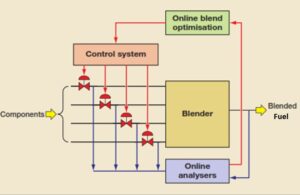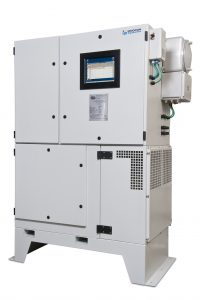 International Maritime Organization (IMO) is moving forward with a marked reduction from 3.5% to 0.5% in the maximum sulfur content of marine fuel (bunker fuel oil) on January 1, 2020. This new regulation will cause a dramatic shift in the demand of marine fuels used globally and will have an immediate impact on global refining.
International Maritime Organization (IMO) is moving forward with a marked reduction from 3.5% to 0.5% in the maximum sulfur content of marine fuel (bunker fuel oil) on January 1, 2020. This new regulation will cause a dramatic shift in the demand of marine fuels used globally and will have an immediate impact on global refining.
In-line bunker fuel blending can represent an extremely cost effective and accurate method of producing fuel, that meets the quality specification (typically ISO8217) and IMO 2020 environmental rules. According to the CE Delft study, bunker fuels between 0.1% and 0.5% sulfur can easily be met by a wide range of blends, as opposed to traditional marine distillates. Its modelling suggests these blends will contain various residuals, treated light cycle oils, treated light distillates and kerosene etc. Some shippers might be also interested to invest in LSFO onboard blending to produce bunker fuel to the required sulphur content, that meets quality specifications.
 Heavy fuel oils and marine bunker oils are blends of heavy refinery products, distillation residues, visbraking residues, thermal cracked residues, and in many cases diluted with CDU distillates such as kerosene, for viscosity adjustment. A broad range of different types of fuels oils as well as bunker oils are brought on the market. These different types are distinguished by differences in viscosity. These materials are of high viscosity, inferior flow properties and with physicochemical properties that do not comply with required specifications.
Heavy fuel oils and marine bunker oils are blends of heavy refinery products, distillation residues, visbraking residues, thermal cracked residues, and in many cases diluted with CDU distillates such as kerosene, for viscosity adjustment. A broad range of different types of fuels oils as well as bunker oils are brought on the market. These different types are distinguished by differences in viscosity. These materials are of high viscosity, inferior flow properties and with physicochemical properties that do not comply with required specifications.
Transformation of these materials as fuel oils or as bunker oils requires blending them with lighter, but still low cost petroleum products such as diesel oils and kerosene, with the target to adapt the major specification properties of interest in fuel oil and bunker fuel oils. These are the viscosity, specific gravity, Conradson carbon residue, flashpoint and sulfur to their requested specification.
Optimization of the blending process to its highest extent requires continuous updating of the simulation model by adapting to real time analytical date. Modcon MOD-4100 on-line analyzer provides a broad range of different real time analytical data of feedstock and final blends in a continuous mode.
Fundamentals and optimized functions of effective blending simulation software includes:
- Measuring physical properties of component streams to be blended
- Measuring the blend properties
- Determination and control of the ratio of blend components to achieve a well-defined blend specification
- Ratio limits
- Properties constraint of the blend
- Constraint limits
- Prices of feed-stock and final blends
- Check component availability
- Volumes of final blends required by the consumers (internal and external)
- Cost of various blend compositions
- Alarms and Controls
Of special interest in blending fuel and bunker oils is to prevent precipitates caused by blending of incompatible feedstocks. Fuel oils and bunker oils are heavy opaque and dense mass. This makes the MOD-4100 process analyzer the only available solution to conduct multiple property analyses by one single system. This feature is of great importance during the blending procedure in the production of different types of fuel and bunker oils.
 Efficient blending of fuel oil and bunker oil is conducted in many cases at elevated temperatures to enable flowing of the feedstocks through pipelines. Fast blending is preferred. Re-blending or repair blended batches that are of border-lined or off-spec quality must be eliminated. The challenge to optimize fuel blending lies in the integration of MOD-4100 process analyzers with blending software. The MOD-4100 process analyzers measure the quality of different feedstocks to be blended, and the final product.
Efficient blending of fuel oil and bunker oil is conducted in many cases at elevated temperatures to enable flowing of the feedstocks through pipelines. Fast blending is preferred. Re-blending or repair blended batches that are of border-lined or off-spec quality must be eliminated. The challenge to optimize fuel blending lies in the integration of MOD-4100 process analyzers with blending software. The MOD-4100 process analyzers measure the quality of different feedstocks to be blended, and the final product.
Transformation of the analytical data into an operating system that automatically calculates, adjusts and fine-tunes the type and ratio of feedstock, such as various cracked materials, various distillates and bottom products, to blend. The optimized blending recipe and its MOD-4100 process analyzer based process control system guarantee the production of such a material, having the required properties and is of lowest cost. Furthermore, the integrated MOD-4100 into predicting blending software enables rapidly to switch between the productions of different types of fuel and bunker oils, according to the demands of the refinery or the shipping company.
The small-scale in-line blending skids can be installed directly on the ship to meet the IMO-2020 maximum allowed SOx emission. This solution normally requires only two fuels HSFO and LSFO to be blended, in order to reach the required maximum of 0.5% sulfur content of marine fuel. This system can be controlled by onboard GPS, which enables to start blending automatically in the ECAs (Emission Control Areas) and to record vessel’s position.
For further details and specifications
Choose the PDF files to download






